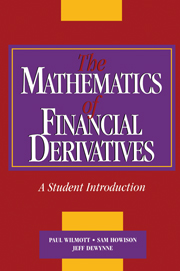Book contents
- Frontmatter
- Contents
- Preface
- Part One Basic Option Theory
- Part Two Numerical Methods
- Part Three Further Option Theory
- 11 Exotic and Path-dependent Options
- 12 Barrier Options
- 13 A Unifying Framework for Path-dependent Options
- 14 Asian Options
- 15 Lookback Options
- 16 Options with Transaction Costs
- Part Four Interest Rate Derivative Products
- Hints to Selected Exercises
- Bibliography
- Index
12 - Barrier Options
from Part Three - Further Option Theory
Published online by Cambridge University Press: 05 June 2012
- Frontmatter
- Contents
- Preface
- Part One Basic Option Theory
- Part Two Numerical Methods
- Part Three Further Option Theory
- 11 Exotic and Path-dependent Options
- 12 Barrier Options
- 13 A Unifying Framework for Path-dependent Options
- 14 Asian Options
- 15 Lookback Options
- 16 Options with Transaction Costs
- Part Four Interest Rate Derivative Products
- Hints to Selected Exercises
- Bibliography
- Index
Summary
Introduction
For our first in-depth discussion of a path-dependent option we consider a vanilla barrier option. As mentioned in the previous chapter, the four basic forms of these options are ‘down-and-out’, ‘down-and-in’, ‘up-andout’ and ‘up-and-in’. That is, the right to exercise either appears (‘in’) or disappears (‘out’) on some boundary in (S, t) space, above (‘up’) or below (‘down’) the asset price at the time the option is created. An example is a European option whose value becomes zero if the asset price ever goes as low as S = X. If the payoff is otherwise the same as that for a call option then we call this product a European ‘downand- out’ call. An ‘up-and-out’ has similar characteristics except that it becomes worthless if the asset price ever exceeds a prescribed amount. These options can be further complicated by making the position of the knockout boundary a function of time and by having a rebate if the barrier is crossed. In the latter case the holder of the option receives a specified amount Z if the barrier is crossed in the case of a ‘down’ option or never crossed in the case of an ‘in’ option; this can make the option more attractive to potential purchasers.
We discuss only European options in any detail and we find a number of explicit formulre for the values of various barrier options. The problem can be readily generalised to incorporate early exercise, although we must then find solutions numerically. In principle, barrier features may be applied to any options.
- Type
- Chapter
- Information
- The Mathematics of Financial DerivativesA Student Introduction, pp. 206 - 212Publisher: Cambridge University PressPrint publication year: 1995
- 1
- Cited by

